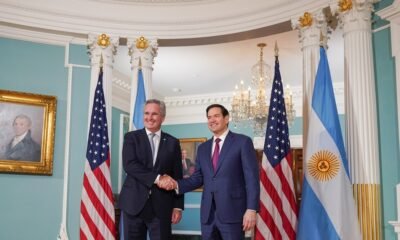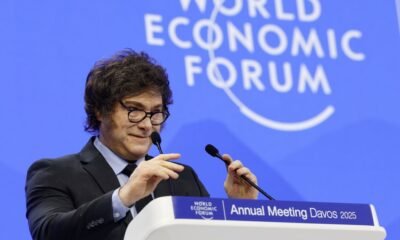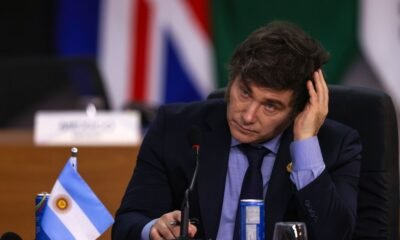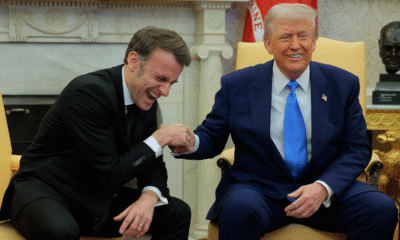INTERNACIONAL
Condena internacional por la violación del espacio aéreo de Polonia por drones rusos: “No fue accidental”

La violación del espacio aéreo de Polonia por drones rusos durante la madrugada del miércoles desató una ola de condenas en Europa y dentro de la OTAN, en un nuevo episodio que eleva la tensión regional.
El primer ministro polaco, Donald Tusk, denunció el incidente como “una provocación a gran escala” contra su país, miembro de la Unión Europea y la OTAN. “Anoche sufrimos una violación del espacio aéreo polaco por parte de un número significativo de drones rusos”, declaró.
En X, añadió: “Aquellos drones que representaban una amenaza directa fueron derribados. Estoy en comunicación constante con el secretario general de la OTAN y con nuestros aliados”.
Desde Kiev, el presidente Volodimir Zelensky advirtió que los hechos representan un grave precedente para Europa. “Hoy hubo otro paso de escalada: los ‘shaheds’ ruso-iraníes operaron en el espacio aéreo de Polonia, en el espacio aéreo de la OTAN. No fue un solo dron que pudiera considerarse un accidente, sino al menos ocho drones de ataque dirigidos hacia Polonia. Un precedente extremadamente peligroso para Europa”, afirmó en X, pidiendo una respuesta fuerte y coordinada de los aliados.
La principal diplomática de la Unión Europea, Kaja Kallas, coincidió en señalar la gravedad del episodio. “Anoche en Polonia presenciamos la violación más grave del espacio aéreo europeo por parte de Rusia desde que comenzó la guerra, y hay indicios de que fue intencionada, no accidental”, escribió en X. “La UE se solidariza plenamente con Polonia. La guerra de Rusia se está intensificando, no termina”, agregó.
En paralelo, la presidenta de la Comisión Europea, Ursula von der Leyen, anunció que Europa defenderá “cada centímetro” de su suelo, instando a inversiones en capacidades estratégicas para reforzar su “flanco oriental” frente a la amenaza de Rusia.
“El flanco oriental de Europa mantiene a toda Europa segura, desde el mar Báltico hasta el mar Negro. Por eso debemos invertir en su apoyo”, declaró ante el Parlamento Europeo en Estrasburgo. “Europa defenderá cada centímetro de su territorio”, concluyó.
La OTAN confirmó que participó en la defensa aérea durante la incursión. “Numerosos drones entraron en el espacio aéreo polaco durante la noche y se encontraron con las defensas aéreas polacas y de la OTAN”, explicó la portavoz Allison Hart, quien agregó que el secretario general, Mark Rutte, está en contacto con Varsovia. Hart informó que los embajadores aliados discutieron este miércoles la respuesta del bloque.
Las reacciones también llegaron de las principales capitales europeas. El presidente francés, Emmanuel Macron, sostuvo en X: “La incursión de drones rusos en el espacio aéreo polaco durante un ataque liderado por Rusia contra Ucrania es simplemente inaceptable. La condeno con la mayor firmeza. Exhorto a Rusia a poner fin a esta precipitada ofensiva. Reitero nuestra plena solidaridad con el pueblo polaco y su gobierno. Hablaré en breve con el secretario general de la OTAN, Mark Rutte. No comprometeremos la seguridad de los aliados”.
El primer ministro sueco, Ulf Kristersson, expresó respaldo a Varsovia. “Las violaciones del espacio aéreo polaco por parte de Rusia esta noche son inaceptables. La guerra de agresión rusa contra Ucrania supone una amenaza para la seguridad de toda Europa. Polonia tiene todo el derecho a defender su espacio aéreo. Le brindamos todo nuestro apoyo, como aliado de la OTAN y miembro de la UE. Suecia y Polonia se mantienen unidos en su apoyo a Ucrania”, aseguró.
La primera ministra de Dinamarca, Mette Frederiksen, calificó la situación de amenaza directa para la región. “Los ataques rusos contra Ucrania y las violaciones del espacio aéreo polaco son totalmente inaceptables. La agresión y las provocaciones rusas constituyen una amenaza para la seguridad de Europa. Dinamarca apoya a Ucrania, Polonia y todos nuestros aliados de la OTAN”, escribió en X.
Diplomacy / Foreign Policy,Europe,Kyiv
INTERNACIONAL
La increíble historia de dos jóvenes de Texas y su plan para invadir una isla caribeña con un ejército de personas sin hogar

Entrenamientos fallidos, viajes y reclutamiento: el derrotero de la conspiración
Cuando un estadounidense fue coronado en Gonâve: la historia exótica que antecede al caso
INTERNACIONAL
Trump says Dems who told military to defy illegal orders committed ‘sedition at the highest level’
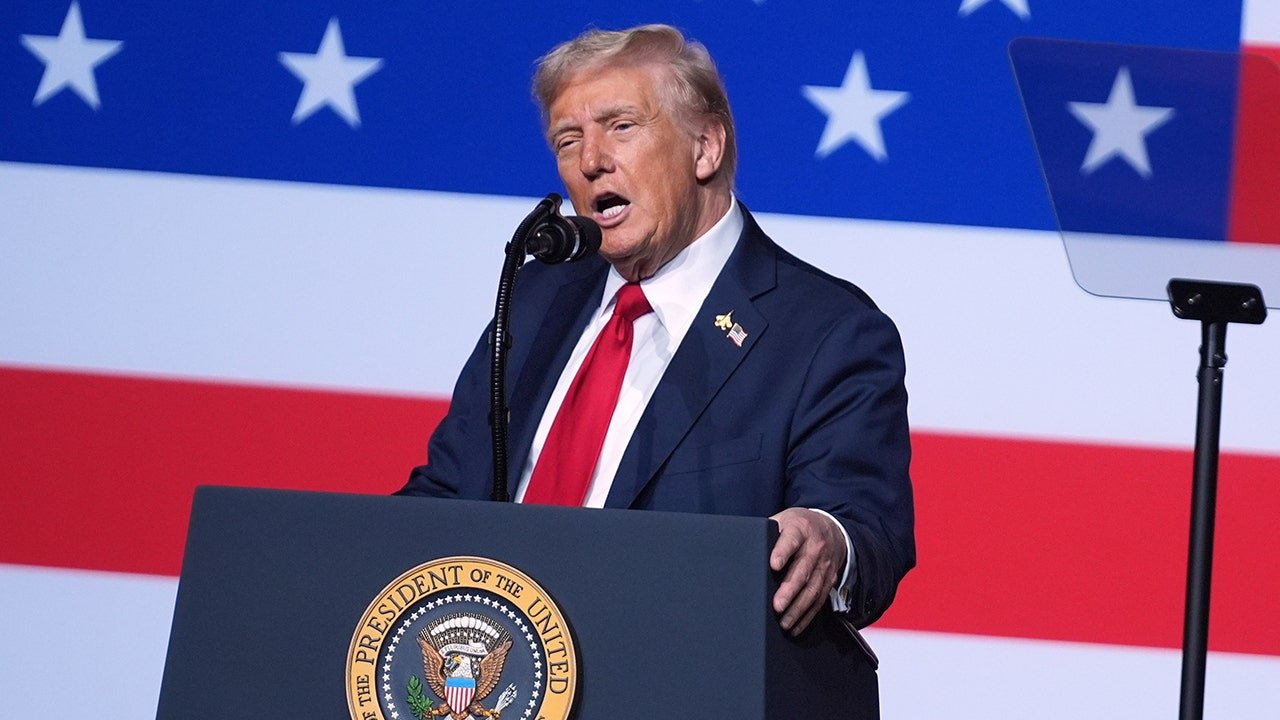
NEWYou can now listen to Fox News articles!
President Donald Trump on Saturday purported that Democrats who urged the military to defy illegal orders engaged in «sedition at the highest level» and «should be in jail right now.»
This comes after one of the lawmakers who appeared in the video calling on troops to ignore unlawful orders, Michigan Sen. Elissa Slotkin, was targeted with a bomb threat just days after the clip and Trump’s subsequent statements suggesting the Democrats be executed.
In a Truth Social post on Saturday, Trump argued that the «traitors» who appeared in the video «should be in jail right now, not roaming the fake news networks trying to explain what they said was OK.»
«It wasn’t, and never will be!» he claimed. «It was sedition at the highest level, and sedition is a major crime. There can be no other interpretation of what they said!»
SEN. SLOTKIN’S HOME TARGETED WITH BOMB THREAT DAYS AFTER SHE TOLD TROOPS TO DEFY ‘ILLEGAL’ ORDERS
President Donald Trump purported that Democrats who urged the military to defy illegal orders engaged in «sedition at the highest level» and «should be in jail right now.» (AP Photo/Evan Vucci)
Trump initially responded to the video message by saying, «SEDITIOUS BEHAVIOR, punishable by DEATH!» He also shared a post from another account that said, «Hang them George Washington would.»
The White House and the president himself later attempted to walk back his comments, saying he did not wish to execute the Democrat lawmakers.
In another post on Saturday, Trump alleged that «many great legal scholars» agree with his position that «the Democrat traitors that told the military to disobey my orders, as president, have committed a crime of serious proportion!»
Slotkin, who previously worked at the CIA and Defense Department, shared the video on Tuesday of herself and other Democrat lawmakers who formerly served in the military and intelligence community encouraging troops and members of the intelligence community to ignore illegal orders from officials.
«This administration is pitting our uniformed military and intelligence community professionals against American citizens,» the lawmakers said. «Like us, you all swore an oath to protect and defend this Constitution. Right now, the threats coming to our Constitution aren’t just coming from abroad but from right here at home. Our laws are clear. You can refuse illegal orders. You must refuse illegal orders. No one has to carry out orders that violate the law or our Constitution.»
SEN. JOHN FETTERMAN ACCUSES TRUMP OF ‘DANGEROUS RHETORIC’

Sen. Elissa Slotkin was targeted with a bomb threat just days after the video and President Donald Trump’s subsequent statements suggesting the lawmakers be executed. (Tom Williams/CQ-Roll Call, Inc via Getty Images; Andrew Harnik/Getty Images)
Other lawmakers in the video included Sen. Mark Kelly of Arizona and Reps. Chris Deluzio and Chrissy Houlahan of Pennsylvania, as well as Reps. Maggie Goodlander of New Hampshire and Jason Crow of Colorado.
Trump administration officials and other Republicans criticized the video, which affirms that refusing unlawful orders is a standard part of military protocol.
Slotkin’s office said on Friday that police responded to her Michigan home following a bomb threat, but that she was not home at the time.
U.S. Capitol Police told her that she would have security at all hours of the day.
«We’ve got law enforcement out in front of my house,» she told MS Now. «It changes things immediately. And leadership climate is set from the top. And if the president is saying you should be hanged, then we shouldn’t be surprised when folks on the ground are going to follow suit and say even worse.»
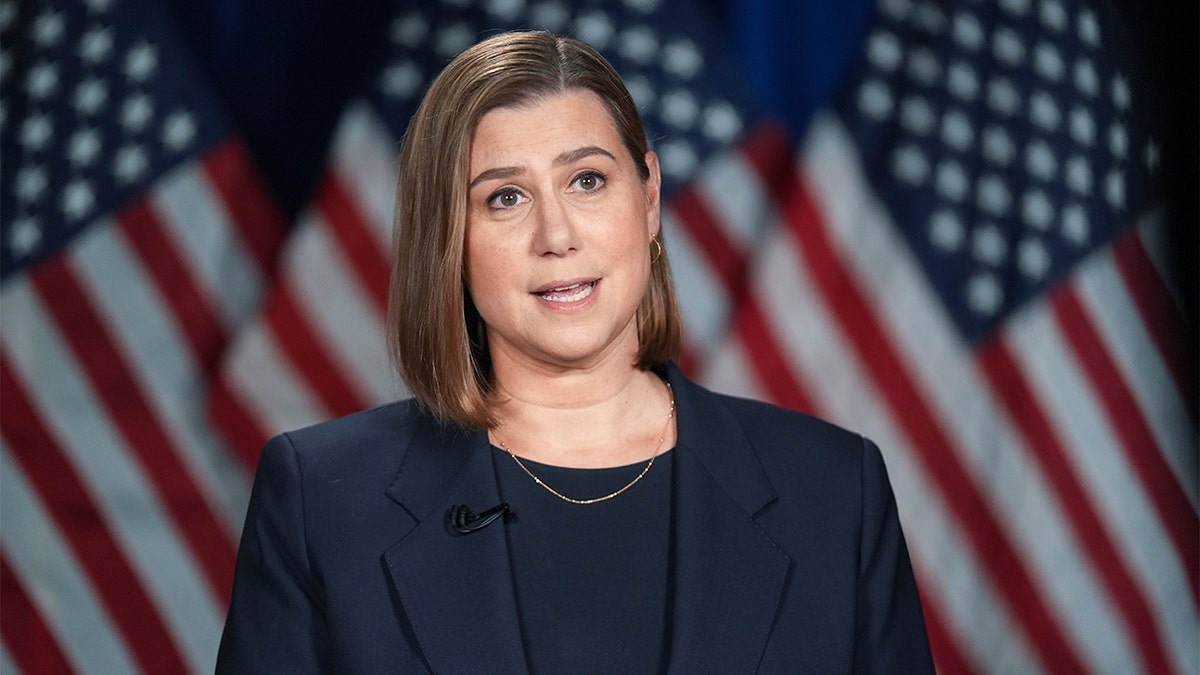
The lawmakers in the video have vowed not to back down despite the threats. (Paul Sancya – Pool/Getty Images)
CLICK HERE TO DOWNLOAD THE FOX NEWS APP
The lawmakers in the video have vowed not to back down despite the threats.
«What’s most telling is that the President considers it punishable by death for us to restate the law. Our servicemembers should know that we have their backs as they fulfill their oath to the Constitution and obligation to follow only lawful orders. It is not only the right thing to do, but also our duty,» they said in a joint statement on Thursday.
«In these moments, fear is contagious, but so is courage. We will continue to lead and will not be intimidated,» the statement added.
donald trump,politics,military,democratic party,democrats senate,constitution
INTERNACIONAL
¿Es malo hacer ejercicio antes de dormir?: esto responden los expertos

En los últimos años, varios estudios de gran escala han concluido que el ejercicio nocturno probablemente no interfiere con el sueño, mientras que otros siguen encontrando una relación negativa en ciertos contextos.
Leé también: Alucinantemente diversos: así eran los perros hace 10 mil años
Consultamos a expertos en sueño y ejercicio para que explicaran qué dice la evidencia sobre entrenar por la noche y cómo eso puede afectar el descanso, y para que compartieran las mejores prácticas para que una rutina antes de dormir funcione a tu favor.
Un ejercicio de intensidad moderada suele ser adecuado
Las investigaciones han demostrado de forma consistente que las rutinas de intensidad baja o moderada antes de dormir no perjudican el sueño, e incluso pueden favorecer un sueño más profundo.
Salir por la noche a caminar, un trote ligero o un paseo tranquilo en bicicleta –o realizar cualquier actividad que no eleve demasiado la frecuencia cardíaca– puede ayudar a reducir el estrés y liberar hormonas que generen bienestar, explicó Christopher Tanayan, cardiólogo deportivo de Northwell Health, en Nueva York. Agregó que el yoga y los estiramientos también pueden fomentar la atención plena, lo que prepara al cuerpo para el descanso.
Sin embargo, incluso algo bueno puede ser demasiado: algunas evidencias sugieren que realizar un entrenamiento de intensidad moderada extremadamente largo –por ejemplo, una carrera de tres horas– por la noche puede dificultar conciliar el sueño y afectar negativamente su calidad, dijo Josh Leota, investigador del sueño y autor principal de un estudio de 2025 que exploró la relación entre la actividad intensa en la noche y los hábitos de sueño.
Para el ejercicio de alta intensidad, la hora sí importa
Para los entrenamientos extenuantes, la evidencia es más contradictoria. Algunos estudios han encontrado que realizar una rutina de alta intensidad poco antes de acostarse tiene pocos efectos negativos sobre el sueño, pero otros sugieren que puede dificultar conciliarlo y mantenerlo.
Muchos expertos creen que los posibles efectos negativos se deben a los cambios fisiológicos que ocurren durante y después del esfuerzo prolongado. En particular, el ejercicio vigoroso eleva la temperatura corporal central, a menudo durante varias horas después de terminar la sesión. Además, el estrés físico activa el sistema nervioso simpático –conocido como la respuesta de “lucha o huida”–, que libera hormonas del estrés, explicó Tanayan.
El ejercicio nocturno intenso a veces dificulta el descanso (Foto: Ilustrativa/Adobe Stock)
Ambas respuestas pueden interferir con el ciclo del sueño. “Si tu temperatura corporal central permanece elevada, eso de hecho le dice a tu cuerpo que aún no es hora de dormir”, agregó. Aunque esto es especialmente cierto en los entrenamientos aeróbicos intensos, también puede pasar con el levantamiento de pesas o con cualquier rutina que someta al cuerpo a un esfuerzo continuo.
“Si el ejercicio es demasiado extenuante, aunque produzca beneficios psicológicos realmente positivos”, puede dejar tu cuerpo en un estado de exaltación que no favorece el sueño, dijo Leota, y agregó: “Es un equilibrio delicado”.
Pero la hora en que se realizan los entrenamientos nocturnos de alta intensidad puede marcar una gran diferencia. Si te gusta ejercitarte con intensidad por la noche y tienes cierta flexibilidad de horarios, procura ir al gimnasio al menos tres horas antes de acostarte, dijo Leota. Ese margen le dará al cuerpo el tiempo necesario para volver a su estado de reposo, señalaron los expertos.
Tal vez tengas que experimentar para encontrar la rutina nocturna que mejor te funcione
Si solo puedes hacer ejercicio por la noche, es mejor entrenar a esa hora que no hacerlo en absoluto, señalaron los expertos. También recordaron que la fisiología y la respuesta al ejercicio nocturno varían ligeramente en cada persona.
Averiguar qué es lo mejor para ti puede requerir algo de ensayo y error, dijo Michael Gradisar, psicólogo clínico y coautor de un estudio de 2021 sobre la actividad física nocturna y el sueño. No te limites a probar una sola vez un determinado régimen de ejercicio nocturno antes de decidir si te funciona, añadió, sino que “repítela una y otra vez”, prestando atención a cómo te sientes durante el día y a lo largo de la semana siguiente.
Si prefieres realizar entrenamientos intensos por la noche, la rutina adecuada podría implicar incluso elegir una o dos noches a la semana en las que duermas un poco menos para poder incluir ese ejercicio de alta intensidad, señaló Matthew Badgett, especialista en medicina del estilo de vida e integral en la Clínica Cleveland.
Leé también: Los expertos coinciden: el ejercicio puede ayudar a controlar el dolor que provoca la artritis de rodilla
En algunas personas, las decisiones que toman en torno a sus entrenamientos –como el lugar donde hacen ejercicio o la forma en que se alimentan antes y después– son las que interfieren con su descanso, explicó Jingyi Qian, investigadora del sueño en Mass General Brigham.
Sea cual sea el tipo o la intensidad del ejercicio que elijas, evita entrenar en un espacio muy iluminado cerca de la hora de dormir, ya que esto puede retrasar tu reloj interno del sueño, explicó Qian. También recomendó evitar las bebidas deportivas con cafeína y las comidas tardías, ya que ambas pueden afectar negativamente el sueño.
“Lo más importante es que no te desanimes a hacer ejercicio si solo puedes hacerlo por la noche”, dijo Qian. “Con un poco de autodiagnóstico y buenos hábitos de sueño, puedes encontrar una rutina que favorezca tanto la forma física como el sueño”.
The New York Times

 POLITICA2 días ago
POLITICA2 días agoTras la orden de decomiso de los bienes de CFK, la Justicia evalúa avanzar sobre el departamento de San José 1111

 POLITICA2 días ago
POLITICA2 días agoJavier Milei sobre las coimas en la ANDIS: “Hay mucha mala intención política”

 CHIMENTOS3 días ago
CHIMENTOS3 días agoEscándalo en MasterChef: cómo fingió Eugenia Tobal su eliminación tras la feroz pelea con Martitegui

